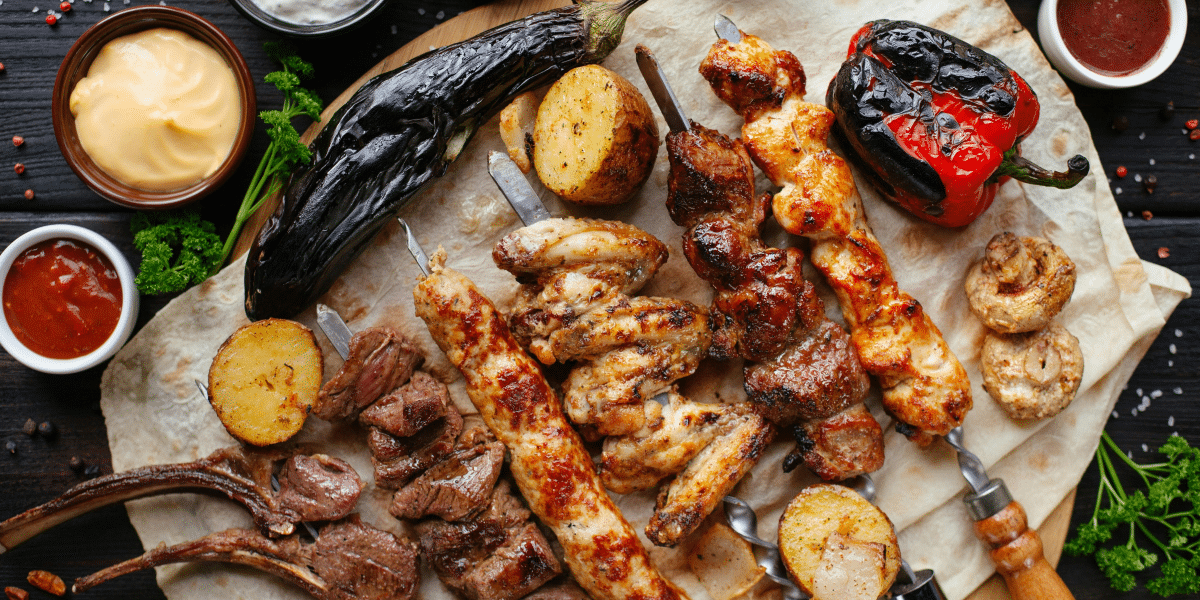Folklore fables and delectable cuisine abound in Saudi Arabia. The earliest civilizations flourished in this region, which is between the Persian and Red Seas. The cuisine of Saudi Arabia reflects the country’s diverse topography, which includes the vast desert (The Rub al Khali), the undulating dry wadis of Najd and the refreshingly cool seaside climate. Its rich history is reflected in its cuisine, which has been greatly influenced by Bedouin customs. Islamic dietary regulations influence the food, prioritizing halal methods and shunning alcohol and pork. Wider Middle Eastern influences can be seen in Saudi dishes like kabsa and jareesh, which are similar to the cuisines of Yemen and the Levant. Persian and Indian spices also contribute to the richness of the flavors. Dishes like Maqluba, which combine a variety of regional influences, clearly display Ottoman heritage. Take advantage of the Umrah packages with flights and taste the variety of dishes in the Kingdom.
Take a Tour Through the Culinary Landscape of Saudi Arabia
The majority of Saudi Arabia is covered in the desert where you can savor Bedouin traditional dishes like meat dishes served with aromatic basmati rice. However, unique fruits, spices and ingredients like apricots, marakh bark lemons etc are found in mountainous provinces like Aseer. You can also find a variety of seafood smothered in olive oil and other regional specialties on the northern coasts where olive trees are abundant.
Margaouq in Riyadh
Let’s begin in Riyadh, the capital of Saudi Arabia. This is the location of Deera sq. dates and the desert. The gracious hospitality of the Najd people in this area, however, is what will really astound you. Aromatic recollections of wandering meals fill the sandy air. Riyadh can also be visited during the Umrah, and Umrah can be performed using Houston Umrah Packages if you are a resident of Houston. Riyadh is famous for its margaouq. Imagine thin slices of whole wheat dough cooked in a flavorful broth with a variety of vegetables and meats. A deliciously substantial dinner that is ideal for the scorching desert climate.
In Makkah Saleeg
The holy city of Makkah, also known as Mecca, is where we next go in western Arabia. This Hejaz regions saleeg is a highly cherished dish. Rice is cooked in a broth made of chicken or another meat, along with milk and cardamom pods, cinnamon, black pepper, bay leaf, and mastic. Taif, a high mountain region noted for its frigid climate, is another place where it’s well-liked. The word Saleeg, which means to boil, is where the name originates. Thanks to Ibrahim Alyamani, a Saudi chef who introduced this dish in 1936 at a Taif neighborhood restaurant, it is recognized that he received the recipe from his father.
Al-Madinahs Madini Rice Dish
In western Arabia, the province of Medina is another stunning location. You have to sample the well-known Arz Madini, also known as Madini Rice, while you’re here. This heartwarming dish of tender meat topped with fragrant white will pull your heart steamed rice in a rich, flavorful broth with a striking red hue.
Muqana Bread, located in Al-Baha
The chilly, misty Al Baha in Southwest Saudi Arabia will surprise you if you assume the country is solely made up of deserts. Muqana Bread is a staple food in the Al Bahah region. Treat yourself to some. Making this customary dish is typically done as a village activity. Together, the women knead and roll out dough made of whole wheat flour, which is then baked over firewood on a heated stone slab until it turns a deep brown color. The soft bread is flavored with saffron and pine, which are typically grown in conjunction with wheat. It is served with lamb stew that is spicy with honey or ghee.
Haneeth during Aseer
Asir is a city in Saudi Arabia tucked away in the southwest. Abha, the capital of the Asir Region, is the most visited tourist attraction. Warm up with a bowl of Heneeth, one of the most well-known dishes connected to the Sala and Markh trees in Asir, while you enjoy the cool weather. The popular dish heneeth is frequently cooked outside in a mahnaz an iron pot.
Ruqsh, In Najran
Moving even further south, we will now reach the province of Najran. Al-Ruqsh is a well-known Najrani dish. To make it thin flatbreads are torn by hand and then topped with boiled eggs and spiced meat (usually lamb). The meal is served in a granite stone bowl known as an al-mudahin which has a palm leaf lid.
Eastern Province Hassawi Rice
Prepare yourself for an exotic journey through Saudi Arabia’s Eastern Province, which is renowned for its abundant oil reserves and exports. Its rich history dates back to the time when the Dilmun civilization lived there. The immense deserts of Rub al Khali are located here. Ahsa is an oasis with refreshing waters and prolific farming nestled within this arid terrain. For centuries, this oasis has supplied fresh water, enabling people to settle and cultivate a variety of crops, including lemons and dates. Hassawi rice, a red variety of rice that grows well in the hot, dry climate of the oasis, is one of the region’s unique products. Red al-Hassawi rice tastes best when cooked with meat or spices. However, because of its labor-intensive nature and high water requirements—which are becoming scarcer because of climate change—its output has dropped recently.

Kleja at Qaseem
Returning to the country’s agricultural heartland, we find ourselves in the central region of Al Qassim, also referred to as the alimental basket. It’s also among the Middle East’s top producers of dates. Here, you’ll experience the typical desert climate with occasional cool, rainy days. While you’re there, you should definitely try Kolucheh, also known as Kleja, a traditional Saudi cookie made with whole wheat flour and packed with ginger cardamom sugar, cinnamon and musky dried black limes. Occasionally glazed with egg wash and flavored with orange blossom or rose water. There are various forms and fillings available for these cookies. The dates-filled ones (kleichat tamur) are the most well-liked.
Keubaibat Hail within Hail
Ancient Ḥaʿil home to the Aja and Salma twin mountain ranges, is rich in historical landmarks such as forts and castles and unusual regional cuisine from Saudi Arabia. Keubaibat Hail, a rice and meat dish from Saudi Arabia’s Hail Province, is a must-try on this historic adventure. To make this dish, the meat is cooked with special spices called Sarar Hail and then stuffed into grape leaves along with basmati rice (Tameen). All the ingredients—bone-in lamb, tomato peppers, and filled grape leaves—are placed in a pot with the tomato broth poured over them and the grape leaves on top.
Mulayhiya along the Northern Borders
Enter the Northern Borders Province which shares borders with Jordan and Iraq if you’re feeling especially daring. Try the local speciality Mulayhiya which consists of rice meat and meat broth topped with pine nuts and fresh parsley.
Al-Jouf-Bukkayla
Al-Jawf Province, which has evidence of human habitation from the Stone Age, is another Northern province that will pique your interest in learning more about traditional Saudi cuisine. One of Saudi Arabia’s most fertile areas, this one hosts numerous festivals honoring the unique crops grown there. The Olive Festival is one of the most well-known celebrations in Al-Jouf. The bakeela or bukayla is one of the region’s speciality dishes. When the grains of the plant called al-Sabeeb are roasted with natural ghee, the dates of Al-Jawf or Al-Helwa are combined with the al-Samh plant.
Getting Lost in the Gastronomy of Saudi Arabia
Eating well is central to Saudi Arabian culture, whether you choose to indulge in the country’s traditional breakfast, dishes try one of the many meat and rice dishes or indulge in street food. Get a Hajj Umrah Visa for a culinary journey across this nation offers a variety of genuine experiences.
Published by: Nelly Chavez



















